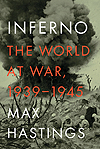
Inferno: The World at War, 1939–1945, by Max Hastings, Knopf, New York, 2011, $35
With eight previous World War II books under his belt, historian Hastings steps back to do the entire war in 752 pages of sweeping strategy and thrilling set pieces.
Nowadays, few historians call this the “Good War,” and Hastings hammers this home, delivering more than the usual nod to civilian as well as military awfulness. Stressing that the Axis and Soviet Union committed the lion’s share of atrocities, he nevertheless reminds us of Allied misdeeds, including the 1943–44 Indian famine, in which millions died on Sir Winston Churchill’s watch. Germans under Adolf Hitler (except for the Jewish ones, of course) enjoyed more freedom than Russians under Joseph Stalin. But the Wehrmacht’s defeat largely occurred on the Eastern Front, where 90 percent of all Germans killed in combat met their fate. Popular writers extol the massive supplies we provided the Soviet Union, but those didn’t arrive in significant quantities until 1943, after the tide had turned.
Readers may squirm when Hastings suggests that the average British and American soldier lacked aggressiveness. The author posits that it was freedom and civil liberties that made soldiers of democracies less willing to sacrifice, though the services that relied more on technology—the navies and air forces—performed better. Hastings makes the case that democracies made war more efficiently: Their industries were more productive, they more effectively supplied and transported troops, they provided almost unlimited firepower, and their intelligence services vastly outperformed those of the enemy.
Always generous with anecdotes, Hastings and his researchers outdid themselves turning up stories beyond the usual sources in the United Kingdom, the United States and Germany. The result is the most downbeat general World War II history in recent memory, but a master like Hastings makes it a gripping experience.
—Mike Oppenheim




